Do look at Brunel’s Other Bridge http://www.brunelsotherbridge.org.uk/ . This holds far more information and shows the latest progress.
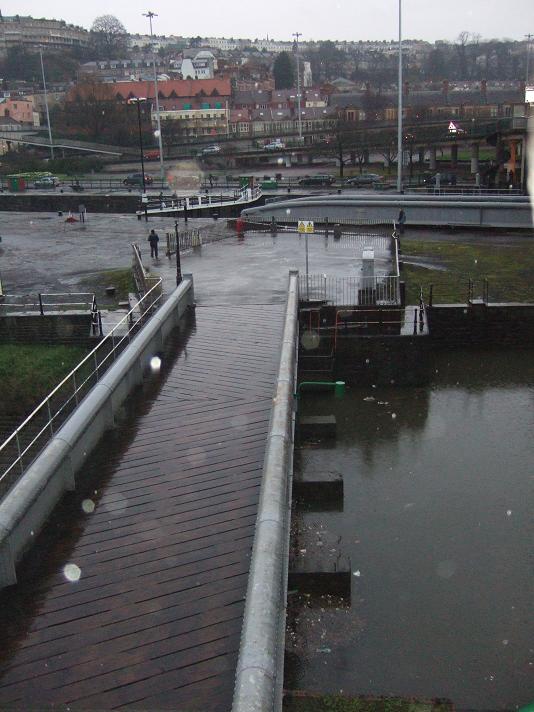
Brunel Swivel Bridge, 1876 replica in foreground Swivel Bridge 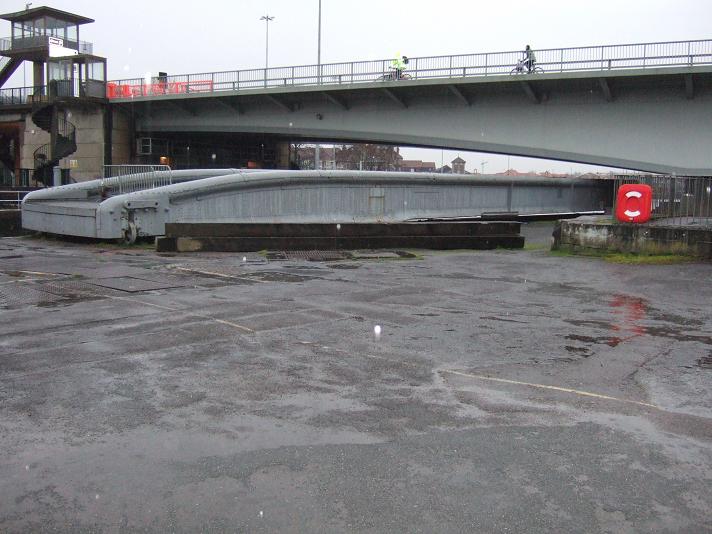
Brunel Swivel Bridge 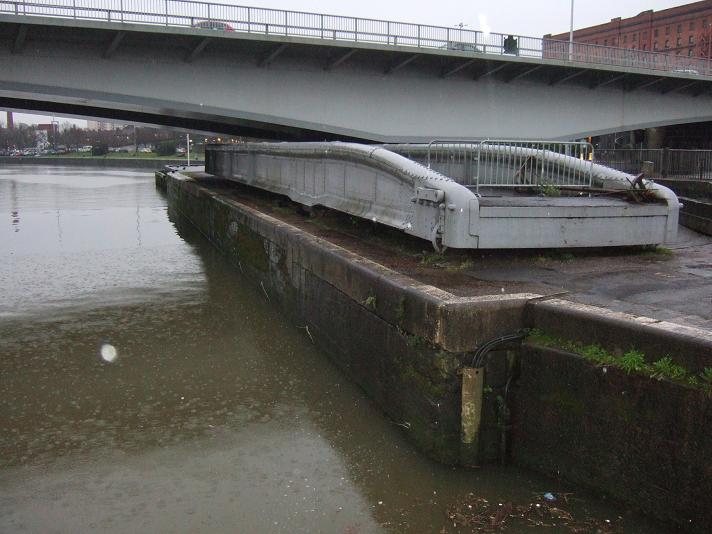
Brunel Swivel Bridge 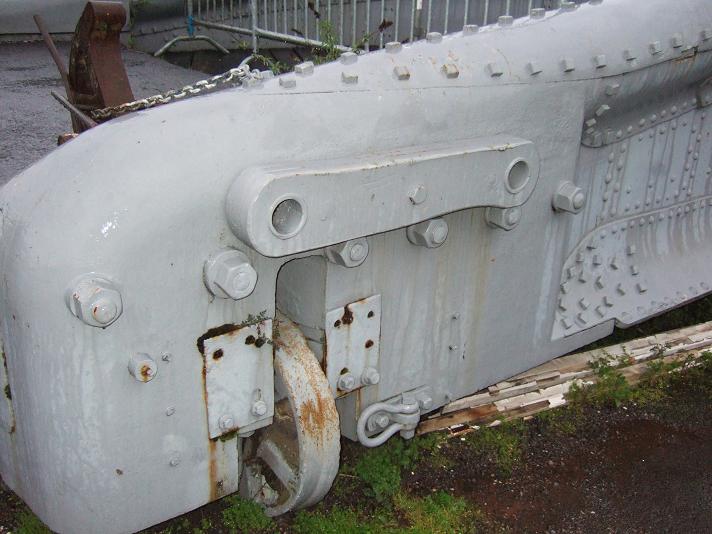
Brunel Swivel Bridge
Details of the following will be found below:
- Introduction
- Proposed Work for 2014
- Work PHASE A Preparation and Basic Conservation by Volunteers
- Progress 2013
Donations
You can make a donation by sending a cheque payable to
Avon Industrial Buildings Trust to:
The Treasurer, Thatched Wells, Duckhole, Thornbury, BS35 1LD.
Introduction
The SWIVEL BRIDGE is Brunel’s first large wrought iron opening bridge, it is far older than the Suspension Bridge, and is Bristol’s only abandoned Brunel structure. The Bridge is listed Grade 2* and is on English Heritage’s Buildings at Risk Register. The bridge rotates on four fixed wheels in contact with a solid ring under the bridge. The bridge was turned by a hydraulic mechanism of twin rams located in pits that are connected to a turning ring under the bridge via a substantial wire cable. The original turning mechanism prior to conversion to hydraulic machinery was a hand turned crank similar to that used on old train turntables. The pistons and chains are still in position. The original hydraulic system ran on fresh water supplied from a pressurised water system sited in Underfall Yard.
Key historical points may be summarised as follows:
- The bridge was designed in 1849 by staff in I.K. Brunel’s Westminster office to carry traffic over the new South Entrance Lock (‘Brunel’s Lock’) in the Cumberland Basin, which was under construction at the time. The bridge became operational in October 1849.
- Brunel himself was closely involved in both its design and its construction. Represents an early stage in the development of the flanged plate girders that characterised Brunel’s later medium span wrought-iron bridges.
- In 1872-1873 the bridge was shortened and relocated to its present position over the North Entrance Lock (‘Howard’s Lock’).
- The hydraulic machinery of the lock was renewed in 1901-1902, manufactured by Sir W.G. Armstrong, Whitworth and Co Ltd of Newcastle upon Tyne.
- The bridge was decommissioned in 1968 after the construction of the Plimsoll Bridge
This project has been supported by CHIS for many years. We now have BIAS, AIBT and the Hotwells and Cliftonwood Society to help as well and do some dirty work. The initial refurbishment project is being led by Geoff Wallis of Dorothea Restorations (gwconservation@gmail.com).
Work for 2014
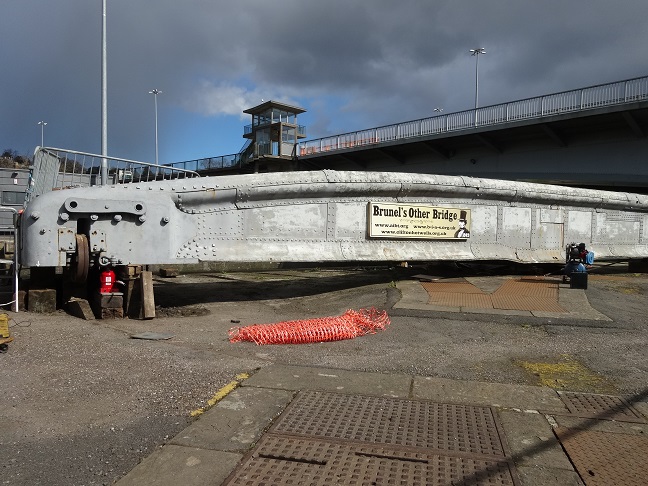
Brunel Swivel Bridge getting lifted higher and higher
- Cleaning and painting rusty areas
- Unbolt and release the centre pintle casting
- Jack up Bridge about 3 inches
- Free up north tail wheel
- Release two rotation cables
- Lower bridge onto its pintle & track
- Free the pintle thread, rotate bridge a small amount and return to present position
Work PHASE A Preparation and Basic Conservation by Volunteers
May 2013:
Aims:
- To improve the site’s neglected appearance
- To slow deterioration
- To raise the Bridge’s profile and solicit initial funding
- To progress the refurbishment of some working parts
- To gain information about the condition of some working parts
Draft Schedule of Work
- Locate and obtain copies of drawings and past reports
- Provide temporary barriers at both ends of the structure to prevent access between the Bridge and basin
- Lay temporary boarding along the west end of the deck to provide access
- Clear debris, vegetation, etc, from around and under the Bridge, and in the hydraulic jigger-pits. Dispose off site
- Scrape/chip off loose rust, apply temporary coating of rust inhibitor
- Free-off the shackle-pins on the steel rope and remove if accessible
- Provide a 2 inch (51mm) spanner/socket, free off and remove 8 pairs of nuts securing the four support-wheel bearing caps. Lift off caps, clean, inspect, record, lubricate and reassemble.
- Provide a spanner/socket, free off and remove 4 pairs of nuts securing the two tail wheel bearing caps. Support the wheels, lift off the caps, clean, inspect, record, lubricate and reassemble.
- Remove deck boards to store on site, and dispose of rubbish, leave the site tidy
It is estimated this will take a work-party of six volunteers 5-6 days to complete.
Progress
September 2013: Putting the signs up certainly raised the profile and we had lots of visitors including two from English Heritage who happened to be passing, and Charlie aged 10 who had been on the Gromit trail ended up helping us all day instead. All the wheel bearings cleaned now. We have also been looking at the skill of the riveter and doing some research.
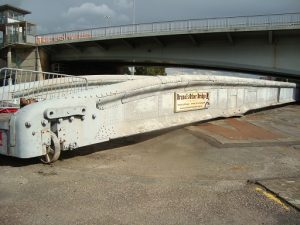
Signs to promote the bridge stand out well. 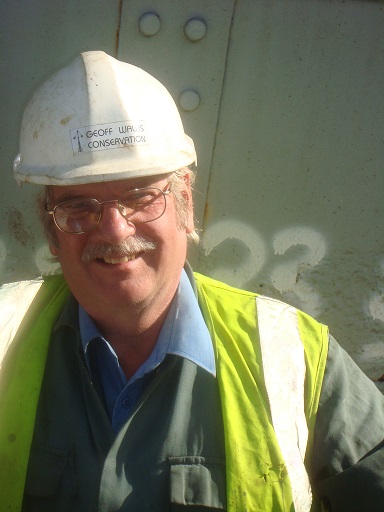
Geoff has every reason to look really happy! 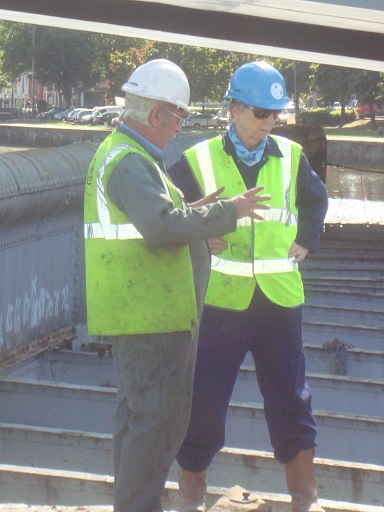
Geoff and Mary Stacey of AIBT discussing matters. 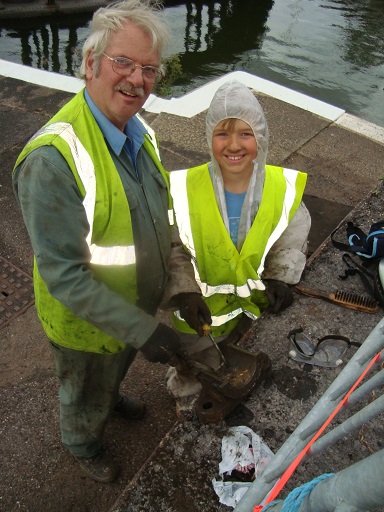
Charlie helping Geoff grease the bearings 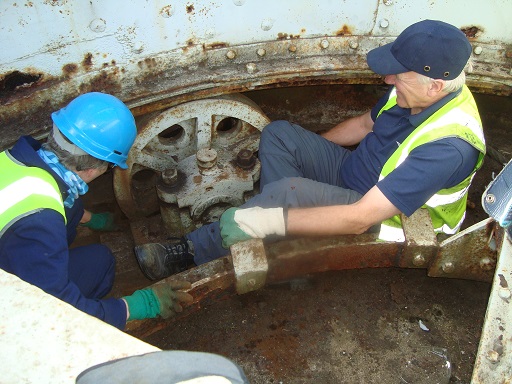
Mike Bone and Mary Stacey digging out the wheel pits as far as possible. 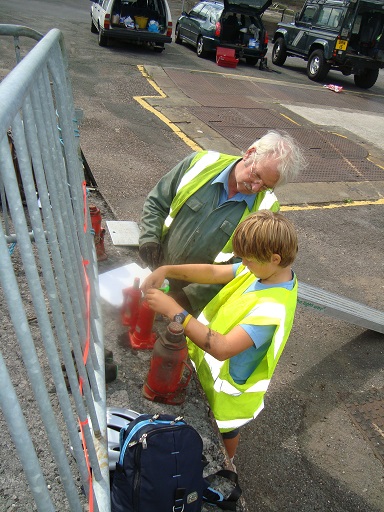
Geoff showing Charlie the different kinds of jack 
Michael discussing the work in progress with Charlie 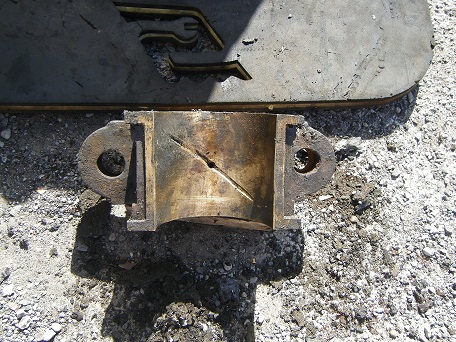
Different style of bearing 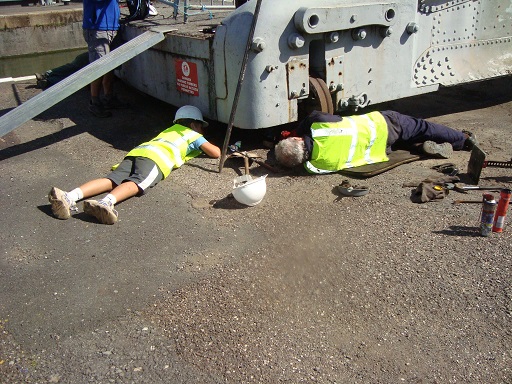
Geoff removing bearing from north tail wheel, and Michael from the south tail wheel with Charlie looking on 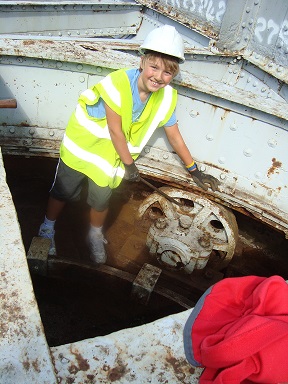
Charlie posing by by a whhel having helped dig out the wheel pit 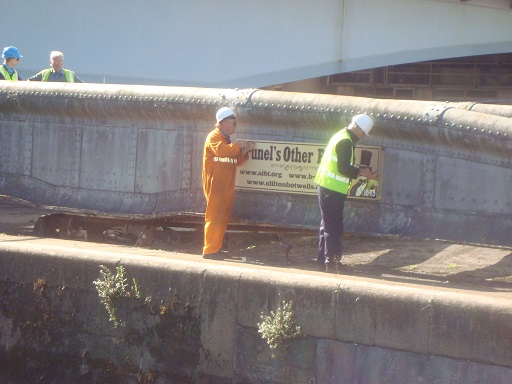
Mike and Michael putting up the sign on the North side with Geoff and Mary discussing above 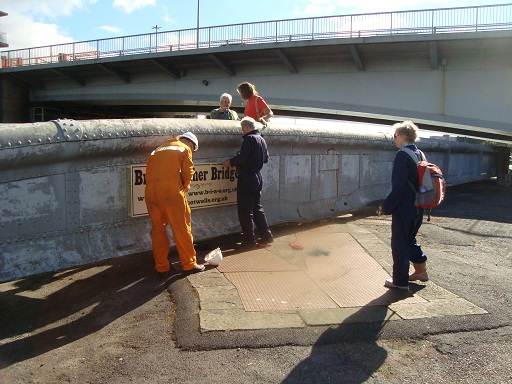
Mike and Michael putting up the sign on the South side with Geoff and a visitor discussing above
August 2013: Another satisfying weekend. 4 more bearings cleaned and lots of rust to worry about. We put some paint on a trial part. All 8 bearings (2 per wheel) have been cleaned and greased now, and we even got a wheel to turn!
We were even treated to looking at the chains that pulled the bridge open during our tea break.
BIAS funded air chisels, tarpaulin, ear defenders, safety goggles
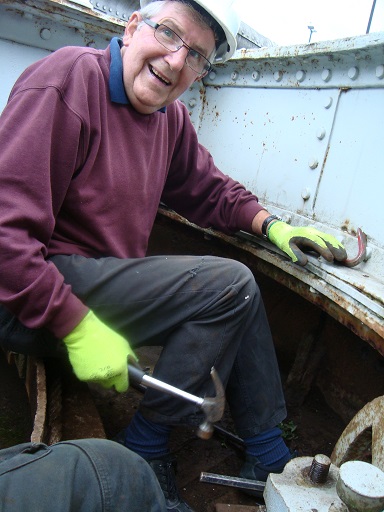
Everyone is happy. This is Dave 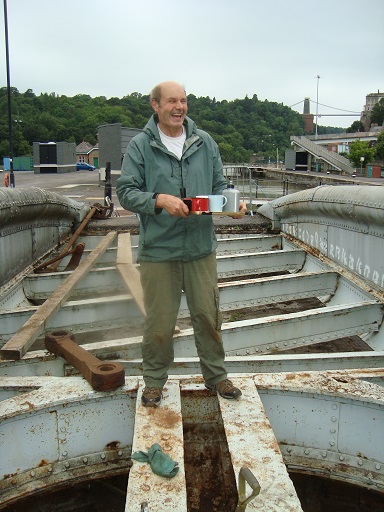
Graham 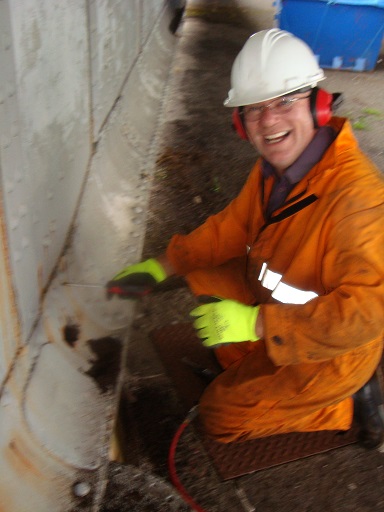
Mike 
Maggie 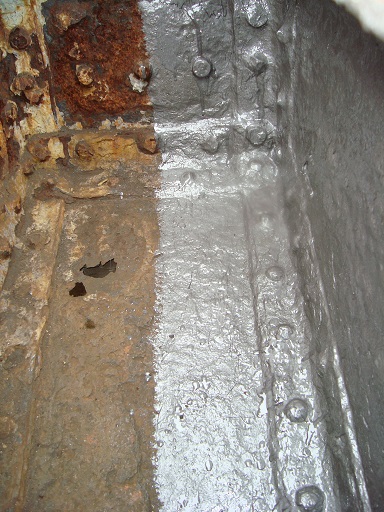
Test paint 
Mike applying the paint 
Wheel pit 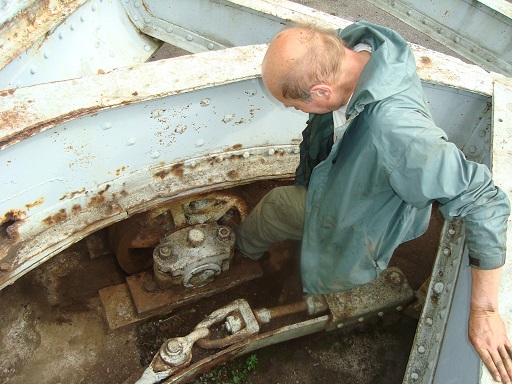
Graham demonstrating the wheel turning easily 
Not much space on outer bearings 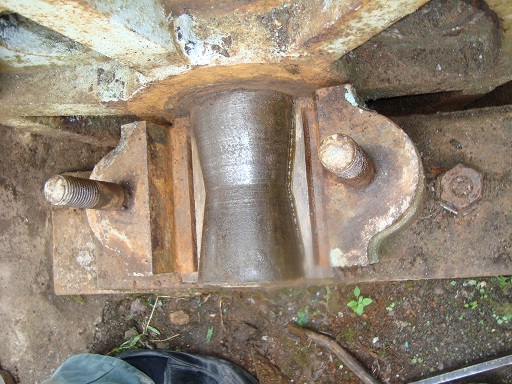
Clean bearing in good condition 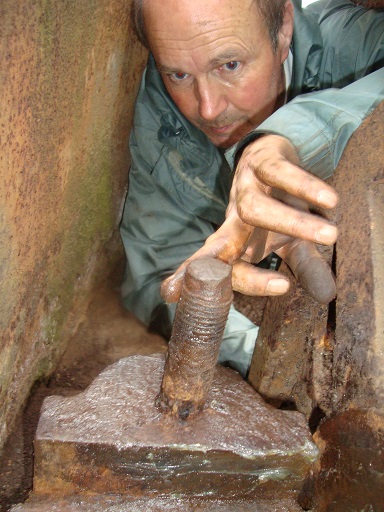
Graham greasing the bearing and studs before cap put on 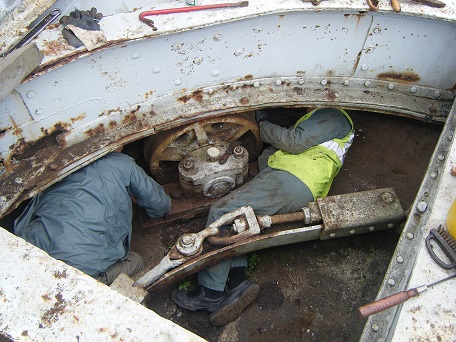
Graham and Geoff getting the wheel to turn 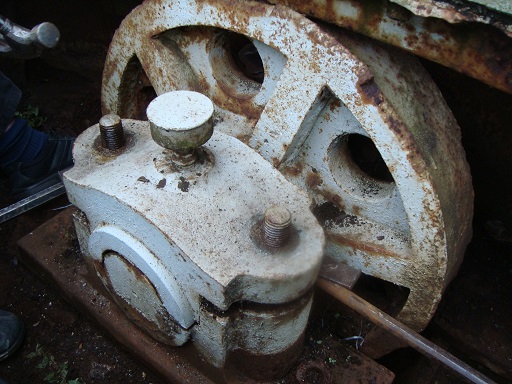
another bearing to move. We cleaned two today- only two more to go 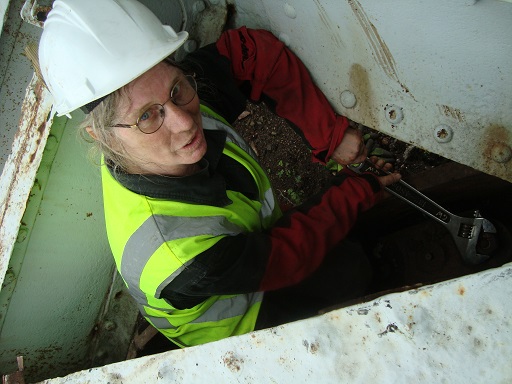
bearing- tight space, big nut 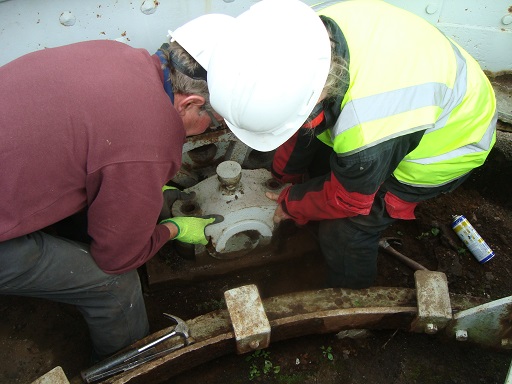
needs two to lift the bearing off 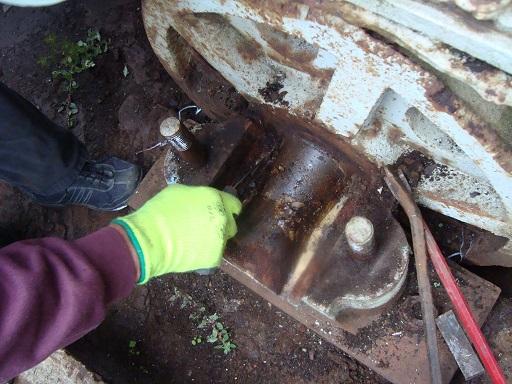
bearing needs cleaning 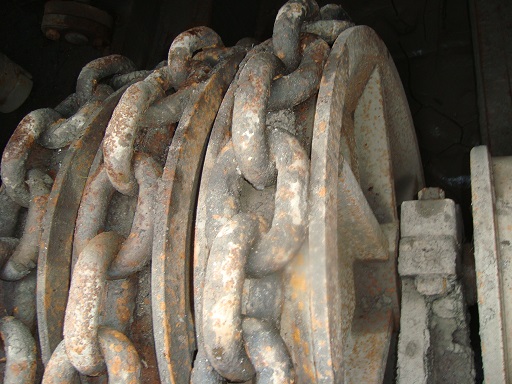
Chains still there 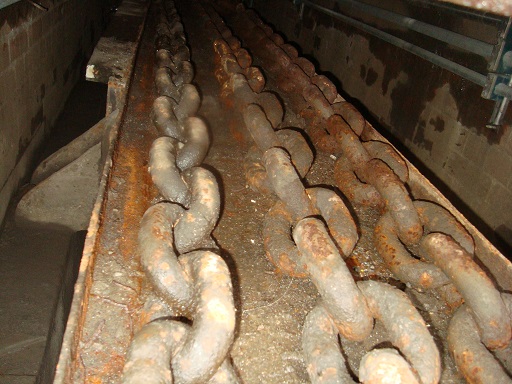
Chains along the dockside 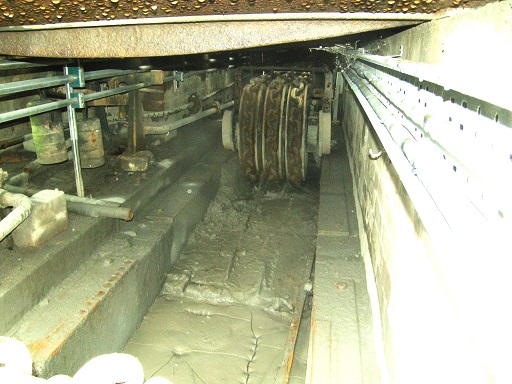
Chain wheels 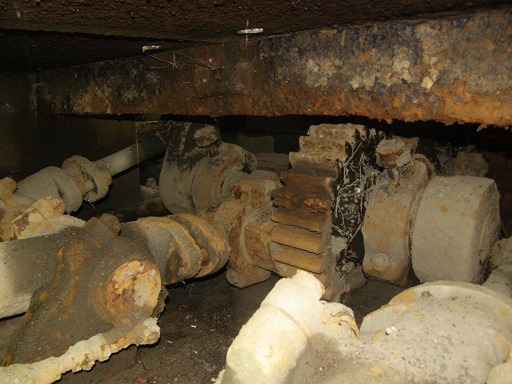
Connecting cogs 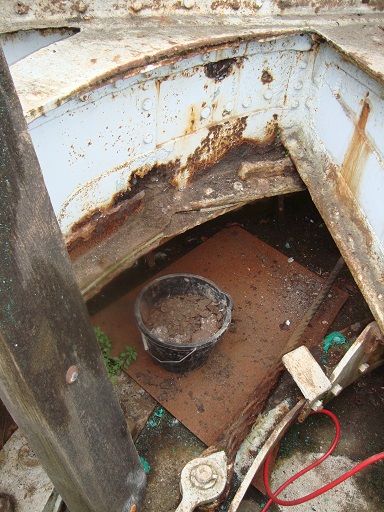
bucket of rust flakes 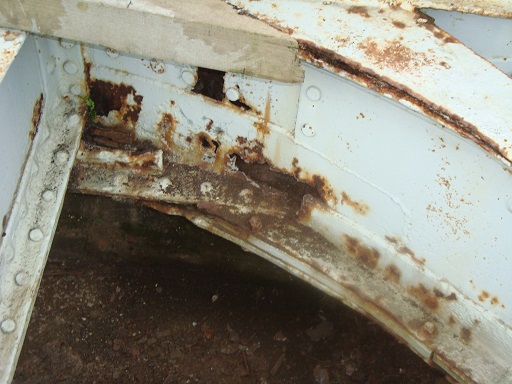
rust on the turning section 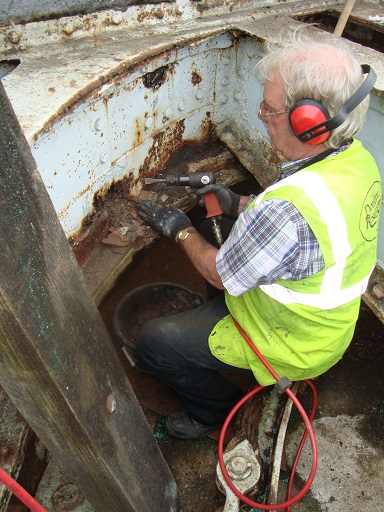
Geoff finding more rust flakes to put in his bucket 
rust on the girder section
June 2013: One wet day organised to improve the neglected appearance by volunteers
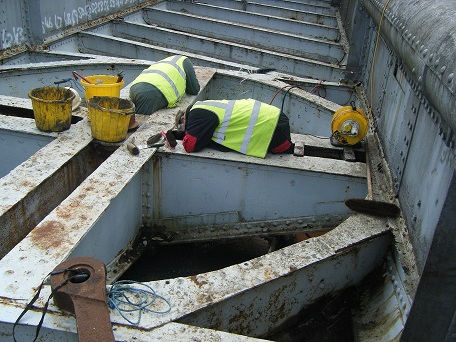
getting stuck in tight spaces again 
Maggie using an air chisel to clean off heavy flakes 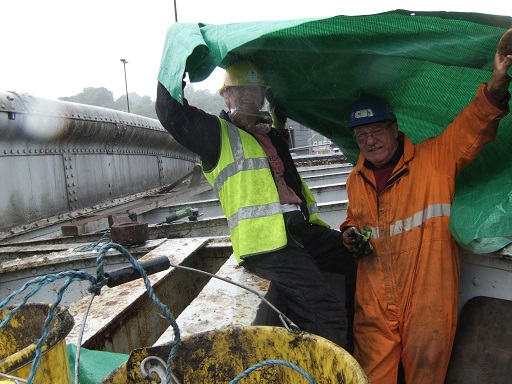
getting very wet 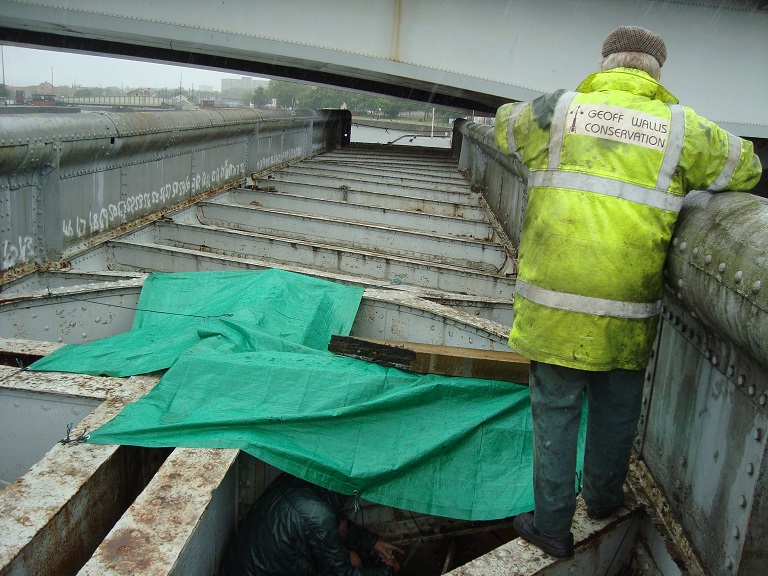
building a shelter
May 2013: Two days organised to improve the neglected appearance by volunteers. CHIS funded paint brushes, scrapers, gloves

Mike Bone chairman of BIAS, cleaning the girders 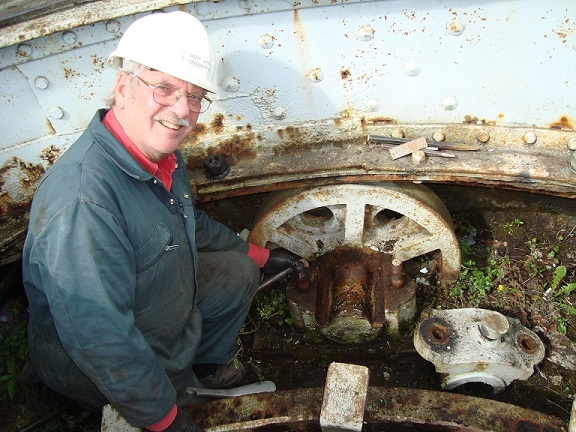
Geoff Wallis of Dorothea and BIAS looking pretty pleased with the progress 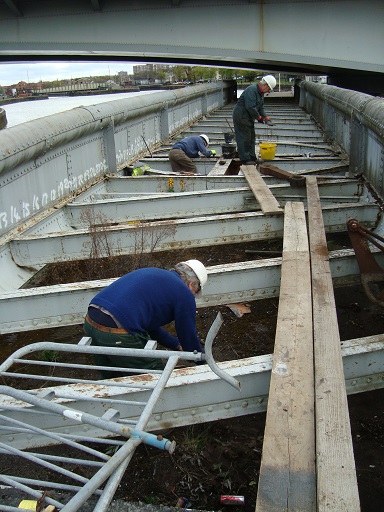
Ray from Hotwells, Geoff and Dave cleaning the girders 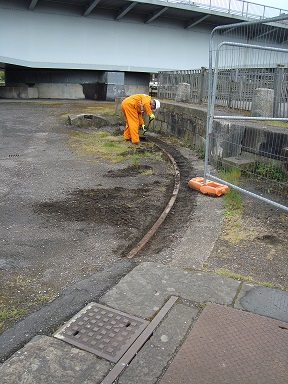
Mike cleaning the rail 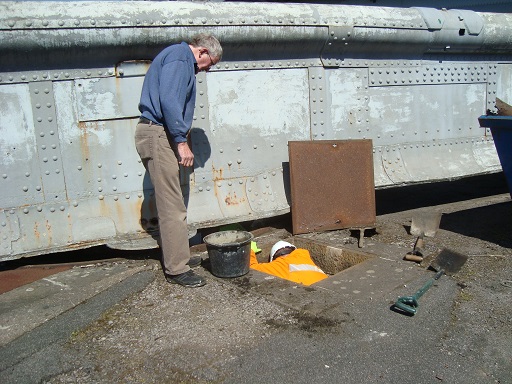
Mike from BIAS down a hole, with Dave standing by 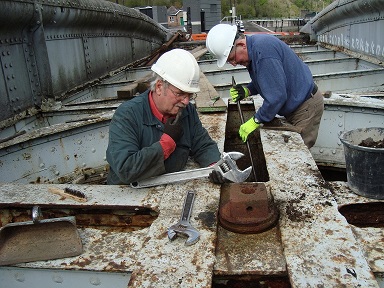
Geoff wondering if his spanner will fit the nut 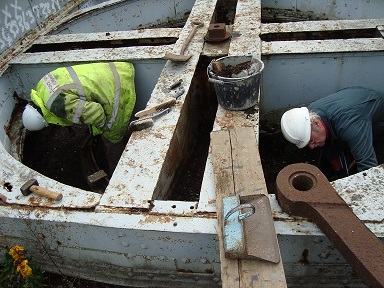
cleaning in a restricted place 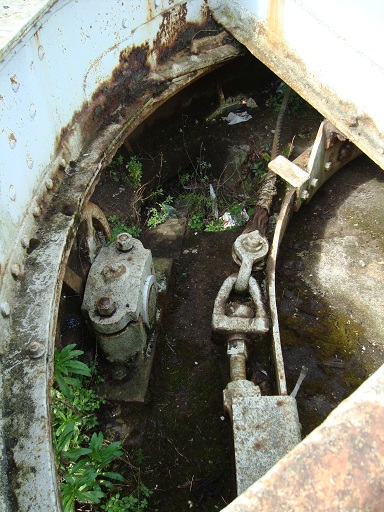
rope connecting the wheels 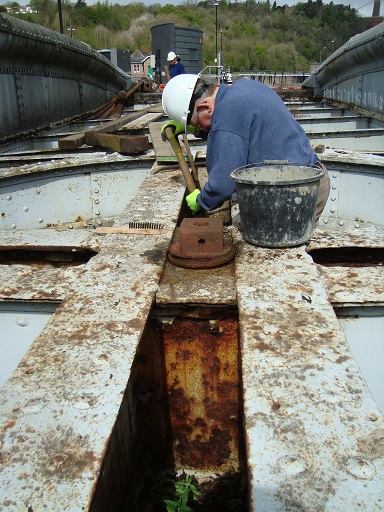
the struts needed cleaning to drain the water awy 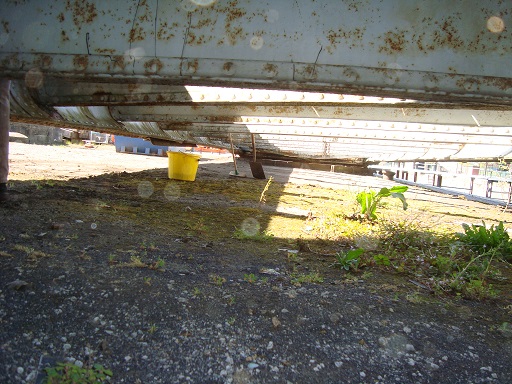
the bridge is only supported by the main pivot 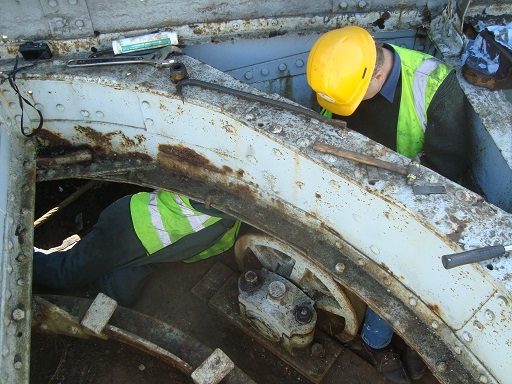
Geoff and Stefan from CHIS inspecting a bearing 
Dave and Maggie from CHIS and BIAS wondering if she would be able to get out
- 7 September: Volunteers continued to excavate the four support wheels and generally clean round them, excavated and cleaned the track under the tail of the Bridge, and took off the tail-wheel bearing caps and serviced the bearings. We put penetrating fluid on the central spigot and wire rope connectors. We could not get any more wheels to turn since the central rim was resting on the wheels. We also put signs up (using existing holes) on either side of the bridge to lift the profile.
- 24, 25 August 2013: Volunteers lifted the caps of the remaining wheel bearings which were found to be in good condition. Some paint was applied to inside one of the struts in a test area to see how effective it would be. Some of the wheel pits were cleared of dirt and a wheel was made to turn. We were concerned about the rust flakes as we cleaned bridge beams.
- 15 June 2013: Volunteers on a wet day tried out an air chisel to see how effective it would be on cleaning off loose rust on the struts
- 4, 6 May 2013: Volunteers from CHIS, AIBT, BIAS, Hotwells and Cliftonwood, Clifton Rocks Railway filled a skip on a bank holiday weekend with the contents of an inspection pit, general dirt from the bridge particularly in the main struts, and weeds from the area. Four wheel bearings had the caps lifted, cleaned, checked and regreased before replacing. They had an unusual tapered design. Started to clear some of the wheel pits of dirt.
- March 2013: The Swivel Bridge Group in coordination with the Bristol Industrial Archaeological Society and the Avon Industrial Buildings Trust and CHIS organise a working party and funds to slow the deterioration of the Bridge, improve its neglected appearance and raise its profile. Support by the Dockmaster given for the first stage. Contact Maggie Shapland for more details
Progress before 2013
- August 2012: As with projects in the past, Geoff Wallis (former Director of Dorothea Resorations) developed a sensible scheme (which would include sliding the bridge to a nearby location for repair), carry out some of the work voluntarily, raise funds from the usual sources, and progress the restoration work in phases.
- July 2012: Site visit to the bridge for BIAS and AIBT
- April 2012: Meeting with the Council
- 12 Apr 2012: Presentation about the Bridge to the Bristol Industrial Society (BIAS) by David Neale, where we learnt of a failed lottery bid mainly due to expensive and controversial proposals to dismember the bridge, remove it to a repair site, possibly on the south quayside of Cumberland Basin, and to return and reassemble repaired components. Afterwards it was decided that the combined efforts of the Brunel Swivel Bridge Group, BIAS, and Avon Industrial Buildings Trust (AIBT) could move this forward independent of the Council, but with their agreement and co-operation.
- 11th January 2012: Brunel Swivel Bridge Consultation Event in the Create Centre
- 23 Nov 2011: A meeting arranged to assist in the formulation of Bristol City Council’s Stage 2 Bid to the Heritage Lottery Fund for re-commissioning the Brunel Swivel Bridge.
- January 2010: Jon Usher, Project Officer, Infrastructure, for Bristol’s Cycling City Team asks for quotations / proposals for the following in respect of the Brunel Swivel Bridge at the entrance to the Bristol City Docks:
- Jacking up the bridge for inspection and refurbishment;
- Carrying out the inspection and producing engineering feasibility reports and estimates for
(a) Restoring the bridge as a static monument and
(b) Re-commissioning the bridge.
- Brunel Bridge plan dropped 29 December 08: Plans for a Festival Way cycling and walking route from Hotwells to Ashton Court and on to Nailsea were intended to bring back into use Brunel’s 160 year old swing bridge that crossed the entrance lock at the western end of the Cumberland Basin. The bridge ceased to be used in 1968 after the new flyover system was built but remains in situ in the ‘open’ (to navigation) position in the shadow of the high level swing bridge and flyover system.
But a recent press release from Sustrans says “The path will cross new lock gates at Brunel’s old swing bridge in the Cumberland Basin before going under the flyover”. The use of the word “at” rather than “on” (Brunel’s bridge) is much more significant than a quick reading would suggest, although the word “near” would be more honest. This confirms suspicions that Bristol City Council are reluctant to restore the historic bridge to working order and will come as a great disappointment to those Bristolians who have pressed for this over many years. - 15 January 08: People from across the UK voted for which bid should get the money from the People’s £50 Million Lottery contest. Sustrans got nearly half the 300,000 votes cast following head-to-head TV bidding. It beat the Eden Project, Sherwood Forest and the Black Country Urban Park. One route Sustrans is planning is Festival Way, linking central Bristol to the Ashton Court Estate, continuing to Long Ashton through Flax Bourton, Backwell, and ending in Nailsea.The Cumberland Basin will be made much easier to use for pedestrians and cyclists, and Brunel’s Swivel Bridge, which has been closed since the late 1960s, will be reopened. It is likely that £250,000 is earmarked for its restoration.
